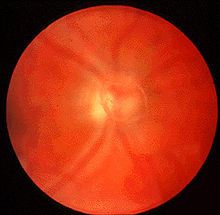- Floater
-
Floater Classification and external resources 
Simulated image of floaters against a blue skyICD-10 H43.9 ICD-9 379.24 DiseasesDB 31270 MedlinePlus 002085 Floaters are deposits of various size, shape, consistency, refractive index, and motility within the eye's vitreous humour, which is normally transparent.[1][2] At young age the vitreous is perfectly transparent, but during life imperfections gradually develop. The common type of floater, which is present in most people's eyes, is due to degenerative changes of the vitreous humour. The perception of floaters is known as myodesopsia,[3] or less commonly as myiodeopsia, myiodesopsia, or myodeopsia.[1] They are also called Muscae volitantes (from the Latin, meaning 'flying flies'), or mouches volantes (from the French). Floaters are visible because of the shadows they cast on the retina[4] or their refraction of the light that passes through them, and can appear alone or together with several others in one's field of vision. They may appear as spots, threads, or fragments of cobwebs, which float slowly before the observer's eyes.[2] Since these objects exist within the eye itself, they are not optical illusions but are entoptic phenomena.
Contents
Description
Floaters are suspended in the vitreous humour, the thick fluid or gel that fills the eye.[5] Thus, they generally follow the rapid motions of the eye, while drifting slowly within the fluid. When they are first noticed, the natural reaction is to attempt to look directly at them. However, attempting to shift one's gaze toward them can be difficult since floaters follow the motion of the eye, remaining to the side of the direction of gaze. Floaters are, in fact, visible only because they do not remain perfectly fixed within the eye. Although the blood vessels of the eye also obstruct light, they are invisible under normal circumstances because they are fixed in location relative to the retina, and the brain "tunes out" stabilized images due to neural adaptation. This stabilization is often interrupted by floaters, especially when they tend to remain visible.[2]
Floaters are particularly noticeable when looking at a blank surface or an open monochromatic space, such as blue sky. Despite the name "floaters", many of these specks have a tendency to sink toward the bottom of the eyeball, in whichever way the eyeball is oriented; the supine position (looking up or lying back) tends to concentrate them near the fovea, which is the center of gaze, while the textureless and evenly lit sky forms an ideal background against which to view them.[5] The brightness of the daytime sky also causes the eyes' pupils to contract, reducing the aperture, which makes floaters less blurry and easier to see.
Floaters are essentially changeless, and the most prominent continue to be seen in the field of vision for a lifetime.[6] They are not uncommon, and do not cause serious problems for most people; they represent one of the most common presentations to hospital eye services. A survey of optometrists in 2002 suggested that an average of 14 patients per month per optometrist presented with symptoms of floaters in the UK.[7] However, floaters are more than a nuisance and a distraction to those with severe cases, especially if the spots seem to constantly drift through the field of vision. The shapes are shadows projected onto the retina by tiny structures of protein or other cell debris discarded over the years and trapped in the vitreous humour. Floaters can even be seen when the eyes are closed on especially bright days, when sufficient light penetrates the eyelids to cast the shadows. It is not, however, only elderly people who are troubled by floaters; they can also become a problem to younger people, especially if they are myopic. They are also common after cataract operations or after trauma. In some cases, floaters are congenital.[8]
Floaters are able to catch and refract light in ways that somewhat blur vision temporarily until the floater moves to a different area. Often they trick people who are troubled by floaters into thinking they see something out of the corner of their eye that really is not there. Most people come to terms with the problem, after a time, and learn to ignore their floaters. For people with severe floaters it is nearly impossible to completely ignore the large masses that constantly stay within almost direct view. Some people have noted that after a while they are able to concentrate much better while reading, watching television, walking outdoors, and driving, especially when tired.
Floaters have been reported in patients as young as 9. However, floaters in teenage patients and young adults are usually harder to treat. For people in this age group, the floater that is seen usually looks like a kind of crystal (translucent) worm/web/cell. These particular floaters aren't really floaters in a technical sense as they aren't found in the vitreous humour, instead they are found right on top of the retina in the Premacular Bursa. Very little is known about this region, and it only becomes distinct after the vitreous detaches from the retina at later stages of life. Due to their microscopic size they cannot be seen by professional doctors. They only appear as big as they do because of their proximity to the retina. These types of floaters are still described occasionally in the third decade and very rarely occur in the 40 or older population.[9][10]
Causes
There are various causes for the appearance of floaters, of which the most common are described here. Simply stated, any damage to the eye that causes material to enter the vitreous humour can result in floaters.
There are websites that advise that causes of floater include, but may not be limited to- rubbing the eye, sleeping on the back or front, smoking, using eye drops or medication or illegal drugs. There is NO evidence to suggest that any of the above causes floaters. Floaters can be a sign of Retinal Detachment or a Retinal Tear but in most (98% according to NHS) cases it is simply age related or due to natural change in the vitreous humour. according to the UK 'Yellow Card Scheme' that allows people to report adverse effects of prescription drugs other than those stated there is one possible case of Ocular Zovirax causing floaters. This is the first (known) report of such a reaction and given the nature of the drug, used to treat Ocular Herpes which can take sight, it is a well understood and very useful drug with a low risk to use factor.
Vitreous syneresis
The most common cause of floaters is shrinkage of the vitreous humour: this gel-like substance consists of 99% water and 1% solid elements. The solid portion consists of a network of collagen and hyaluronic acid, with the latter retaining water molecules. Depolymerization of this network makes the hyaluronic acid release its trapped water, thereby liquefying the gel. The collagen breaks down into fibrils, which ultimately are the floaters that plague the patient. Floaters caused in this way tend to be few in number and of a linear form.[citation needed]
Posterior vitreous detachments and retinal detachments
In time, the liquefied vitreous body loses support and its framework contracts. This leads to posterior vitreous detachment, in which the vitreous body is released from the sensory retina. During this detachment, the shrinking vitreous can stimulate the retina mechanically, causing the patient to see random flashes across the visual field, sometimes referred to as "flashers", a symptom more formally referred to as photopsia. The ultimate release of the vitreous around the optic nerve head sometimes makes a large floater appear, usually in the shape of a ring ("Weiss ring").[11] As a complication, part of the retina might be torn off by the departing vitreous body, in a process known as retinal detachment. This will often leak blood into the vitreous, which is seen by the patient as a sudden appearance of numerous small dots, moving across the whole field of vision. Retinal detachment requires immediate medical attention, as it can easily cause blindness. Consequently, both the appearance of flashes and the sudden onset of numerous small floaters should be rapidly investigated by an eye care provider.[12]
Regression of the hyaloid artery
The hyaloid artery, an artery running through the vitreous humour during the fetal stage of development, regresses in the third trimester of pregnancy. Its disintegration can sometimes leave cell matter.[13]
Other common causes
Patients with retinal tears may experience floaters if red blood cells are released from leaky blood vessels, and those with a posterior uveitis or vitritis, as in toxoplasmosis, may experience multiple floaters and decreased vision due to the accumulation of white blood cells in the vitreous humour.[14]
Other causes for floaters include cystoid macular edema and asteroid hyalosis. The latter is an anomaly of the vitreous humour, whereby calcium clumps attach themselves to the collagen network. The bodies that are formed in this way move slightly with eye movement, but then return to their fixed position.
Tear film debris
Sometimes the appearance of floaters has to be attributed to dark specks in the tear film of the eye. Technically, these are not floaters, but they do look the same from the viewpoint of the patient. People with blepharitis or a dysfunctional meibomian gland are especially prone to this cause, but ocular allergies can also cause the problem.[citation needed] To differentiate between material in the vitreous humour of the eye and debris in the tear film, one can look at the effect of blinking: debris in the tear film will move quickly with a blink, while floaters are largely unresponsive to it. Tear film debris is diagnosed by eliminating the possibility of true floaters and macular degeneration.
Diagnosis
Floaters are often readily observed by an ophthalmologist or an optometrist with the use of an ophthalmoscope or slit lamp. However, if the floater is near the retina, it may not be visible to the observer even if it appears large to the sufferer.
Increasing background illumination or using a pinhole to effectively decrease pupil diameter may allow a person to obtain a better view of his or her own floaters. The head may be tilted in such a way that one of the floaters drifts towards the central axis of the eye. In the sharpened image the fibrous elements are more conspicuous. [15]
The presence of retinal tears with new onset of floaters was surprisingly high (14%; 95% confidence interval, 12%-16%) as reported in a metaanalysis published as part of the Rational Clinical Examination Series in the Journal of the American Medical Association.[16] Patients with new onset flashes and/or floaters, especially when associated with visual loss or restriction in the visual field, should seek more urgent ophthalmologic evaluation.
Treatment
Most commonly, there is no treatment recommended.[citation needed]
- Vitrectomy may be successful in treating more severe cases;[17][18] however, the procedure is typically not warranted in those with lesser symptoms due to the potential for complications to include cataracts, retinal detachment, and severe infection.[citation needed] The technique usually involves making three openings through the part of the sclera known as the pars plana. Of these small gauge instruments, one is an infusion port to resupply a saline solution and maintain the pressure of the eye, the second is a fiber optic light source, and the third is a vitrector. The vitrector has a reciprocating cutting tip attached to a suction device. This design reduces traction on the retina via the vitreous material. A variant sutureless, self-sealing technique is sometimes used.
- Laser vitreolysis:[19][20] In this procedure an ophthalmic laser (usually an Yttrium aluminium garnet "YAG" laser) is focused onto the floater and in a series of brief bursts, the laser vaporizes and lyses (cuts) the collagen strands of the floater. As of July 2010, laser treatment is not widely practiced and is only performed by very few specialists in the world. It is an outpatient process, which is much less invasive to the eye than a vitrectomy, with potentially fewer side effects.
Descriptions in literature
- "A common experience... is for a person who has some ocular trouble that impairs his vision to become suddenly aware of the so-called mouches volantes in his visual field, although the causes of this phenomenon have been there in the vitreous humor all his life. Yet now he will be firmly persuaded that these corpuscles have developed as the result of his ocular ailment, although the truth simply is that, owing to his ailment, the patient has been paying more attention to visual phenomena."[21]
- "They could have done the same thing, alone, in the back yard, seeing the shapes swimming in the sky. I forget how old I was when I asked somebody about it, and I was told that those wonderful gliding changing spots were imperfections in the fluid of my eye-ball, that what I was seeing was in my eye. In your eye! For so long, for a child's years, the sky was full of wonder, these shapes were in the sky, the sky was full of transparent things that swooped and swam. They were almost invisible, and, I thought, almost bodiless, they were there, but you could go right through them, they were animals that lived in the air. You see, we didn't go around talking about things like this. It's only now, when I am grown up and know everything, that I talk about this."[22]
- "At first the amoebae look like muscae volitantes, those curled moving spots you seem to see in your eyes when you stare at a distant wall. Then I see the amoebae as drops of water congealed, blusish, translucent, like chips of sky in the bowl."[23]
See also
- Blue field entoptic phenomenon, alias Scheerer's phenomenon - tiny bright dots moving quickly in the visual field.
- Phosphene
- Synchysis scintillans
Notes
- ^ a b Cline D; Hofstetter HW; Griffin JR. Dictionary of Visual Science. 4th ed. Butterworth-Heinemann, Boston 1997. ISBN 0-7506-9895-0
- ^ a b c "Facts about floaters". National Eye Institute. December 2007. http://www.nei.nih.gov/health/floaters/index.asp. Retrieved February 2008.
- ^ From Greek μυιώδης "fly-like" (Myiodes was also the name of a fly-deterring deity) and ὄψις "sight."
- ^ American Academy of Ophthalmology. "Floaters and Flashes: A Closer Look" (pamphlet) San Francisco: AAO, 2006. ISBN 1-56055-371-5
- ^ a b "Eye floaters and spots; Floaters or spots in the eye". National Eye Institute. http://www.eyecaresource.com/conditions/eye-floaters/. Retrieved February 2008.
- ^ http://www.formulamedical.com/Topics/Head&Neck/Eye%20floaters%20vitreous.htm Floaters may remain indefinitely
- ^ Craig Goldsmith; Tristan McMullan, Ted Burton (2007). Floaterectomy Versus Conventional Pars Plana Vitrectomy For Vitreous Floaters. Digital Journal of Ophthalmology. http://www.djo.harvard.edu/site.php?url=/physicians/oa/1004. Retrieved 2008-04-11
- ^ "Floaters". Prevent Blindness America. 2005. http://www.preventblindness.org/eye_problems/floatersFAQ.html. Retrieved February 2008.
- ^ "Floaters". Young Floaters. 2008. http://www.vitreousfloatersolutions.com/floaters_young.html. Retrieved February 2008.
- ^ "Floaters". Young Floaters. 2008. http://www.vitreousfloaters.com/faq.html. Retrieved February 2008.
- ^ "Flashes & Floaters". The Eye Digest. http://www.agingeye.net/visionbasics/flashesandfloaters.php. Retrieved 2008-02-24.
- ^ "Flashes and Floaters (Posterior Vitreous Detachment)". St. Luke's Cataract & Laser Institute. http://www.stlukeseye.com/Conditions/Floaters.asp. Retrieved February 2008.
- ^ Floaters in fetal development[dead link]
- ^ Alan G. Kabat; Joseph W. Sowka (April 2009). "A clinician’s guide to flashes and floaters" (PDF). optometry.co.uk. http://www.optometry.co.uk/articles/docs/640c1a5b606a7d89320511ca29ccc288_kabat20010323.pdf. Retrieved 2008-04-10
- ^ Judith Lee, and Gretchyn Bailey;; Dr. Vance Thompson. "Eye floaters and spots". All about vision. http://www.allaboutvision.com/conditions/spotsfloats.htm. Retrieved February 2008.
- ^ Hollands H, Johnson D, Brox AC, Almeida D, Simel DL, Sharma S. Acute-onset floaters and flashes: is this patient at risk for retinal detachment? JAMA. 2009 Nov 25;302(20):2243-9.
- ^ Roth M, Trittibach P, Koerner F, Sarra G. "[Pars plana vitrectomy for idiopathic vitreous floaters.]" Klin Monatsbl Augenheilkd. 2005 Sep;222(9):728-32. PMID 16175483.
- ^ [dead link] "Pars plana vitrectomy (PPV) & floater only vitrectomy". http://www.eye-floaters.com/treatingfloaters-vitrectomy.php[dead link]. Retrieved February 2008.
- ^ "Using Lasers to Treat Vitreous Floaters)". http://irvaronsjournal.blogspot.com/2010/08/using-lasers-to-treat-vitreous-floaters.html. Retrieved August 2010.
- ^ Delaney YM, Oyinloye A, Benjamin L (2002). "Nd:YAG vitreolysis and pars plana vitrectomy: surgical treatment for vitreous floaters". Eye 16 (1): 21–26. doi:10.1038/sj.eye.6700026. PMID 11913884.
- ^ H. von Helmholtz, Handbuch der Physiologischen Optik, published as "Helmholtz's Treatise on Physiological Optics, Translated from the Third German Edition," ed. James P. C. Southall, 1925, The Optical Society of America. v. III, pp. 6-7
- ^ Robert Paul Smith (1956). Where Did You Go? Out. What Did You Do? Nothing.. New York: Norton.
- ^ Annie Dillard (1974). Pilgrim at Tinker Creek. Toronto: Bantam.
External links
- About Floaters
- One Clear Vision - UK-based, international charity for sufferers of Degenerative Vitreous Syndrome (floaters)
- Video Representation of Floaters by filmmaker David OReilly
- Picture of the entoptic phenomenon: Vitreous Floaters (PDF file)
- Eye floaters - subjective vision simulator from Floatershell.com
- Degenerative Vitreous Community - Discussion Forum
Phenomena of the visual system Entoptic phenomena Blind spot · Phosphene · Floater · Afterimage · Haidinger's brush · Prisoner's cinema · Blue field entoptic phenomenon · Purkinje imagesOther phenomena M: EYE
anat(g/a/p)/phys/devp/prot
noco/cong/tumr, epon
proc, drug(S1A/1E/1F/1L)
Categories:- Vision
- Disorders of vitreous body and globe
Wikimedia Foundation. 2010.


